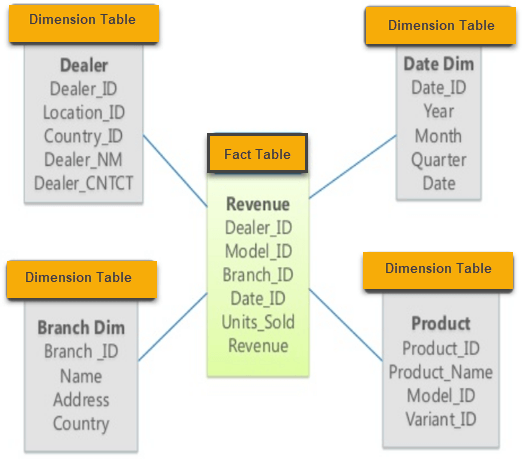Star Schema vs Snowflake Schema – Difference Between Them
Key Difference Between Star Schema and Snowflake Schema
- The star schema is the simplest type of Data Warehouse schema. It is known as star schema as its structure resembles a star.
- Comparing Snowflake vs Star schema, a Snowflake Schema is an extension of a Star Schema, and it adds additional dimensions. It is called snowflake because its diagram resembles a Snowflake.
- In a star schema, only single join defines the relationship between the fact table and any dimension tables.
- Star schema contains a fact table surrounded by dimension tables.
- Snowflake schema is surrounded by dimension table which are in turn surrounded by dimension table
- A snowflake schema requires many joins to fetch the data.
- Comparing Star vs Snowflake schema, Start schema has simple DB design, while Snowflake schema has very complex DB design.
What is a Star Schema?
Star Schema in data warehouse, in which the center of the star can have one fact table and a number of associated dimension tables. It is known as star schema as its structure resembles a star. The Star Schema data model is the simplest type of Data Warehouse schema. It is also known as Star Join Schema and is optimized for querying large data sets.
In the following Star Schema example, the fact table is at the center which contains keys to every dimension table like Dealer_ID, Model ID, Date_ID, Product_ID, Branch_ID & other attributes like Units sold and revenue.

What is a Snowflake Schema?
Snowflake Schema in data warehouse is a logical arrangement of tables in a multidimensional database such that the ER diagram resembles a snowflake shape. A Snowflake Schema is an extension of a Star Schema, and it adds additional dimensions. The dimension tables are normalized which splits data into additional tables.
In the following Snowflake Schema example, Country is further normalized into an individual table.

Difference between Star Schema and Snowflake Schema
Following is a key difference between Snowflake schema vs Star schema:
| Star Schema | Snowflake Schema |
|---|---|
| Hierarchies for the dimensions are stored in the dimensional table. | Hierarchies are divided into separate tables. |
| It contains a fact table surrounded by dimension tables. | One fact table surrounded by dimension table which are in turn surrounded by dimension table |
| In a star schema, only single join creates the relationship between the fact table and any dimension tables. | A snowflake schema requires many joins to fetch the data. |
| Simple DB Design. | Very Complex DB Design. |
| Denormalized Data structure and query also run faster. | Normalized Data Structure. |
| High level of Data redundancy | Very low-level data redundancy |
| Single Dimension table contains aggregated data. | Data Split into different Dimension Tables. |
| Cube processing is faster. | Cube processing might be slow because of the complex join. |
| Offers higher performing queries using Star Join Query Optimization. Tables may be connected with multiple dimensions. |
The Snowflake schema is represented by centralized fact table which unlikely connected with multiple dimensions. |
